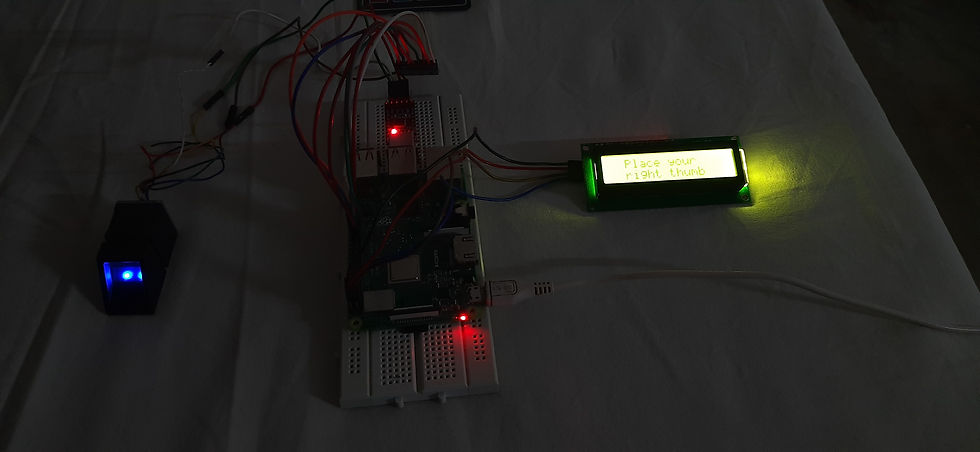Fingerprint Sensor-based Attendance System
- shrey mittal

- Aug 9, 2020
- 3 min read
Updated: Sep 28, 2024
In today's world, our identity is very important and our identity is now being represented by our #fingerprint or our retina and even our voice. Most of our government documents are being identified using our fingerprint. Many companies and colleges use fingerprint #attendancesystem since they cannot be deceived.
A fingerprint biometric seems to be a very complex thing but if we study and read about it, it's pretty easy to make and a little cheaper than what's available in the market. In this, we will use the R305/R307 Fingerprint Sensor and connect it with #raspberrypi.
Hardware required:

Raspberry pi 3 Model B: It is the first design in the third generation. They are a single-board computer to provide the processing at a very low cost. It comes with a Quad-Core 1.2GHz Broadcom BCM2837 64bit CPU and a 1GB RAM and can be controlled wirelessly through WIFI and has 40 GPIO pins and is easy to set up.

R307 FingerprintSensor Module: R307 is the newer and upgraded version of R305 with an up-gradation of storing fingerprints up to 1000 and USB operation. it consists of an optical fingerprint sensor, high-speed DSP processor, the high-performance fingerprint alignment algorithm.

LCD: It is also called JHD162A 16x2 LCD Display it is a 16x2 display to show the appropriate information.

I2C module: It has an inbuilt PCF8574 I2C chip that converts serial data to parallel data for the LCD. It is soldered to the pins of the LCD.

CP2102 USB to TTL converter module: The board can simply attach to a USB bus and will appear as a standard COM port.

4x4 Keypad: It contains 16 buttons which can be connected to Arduino.

Breadboard and Jumper Wire: They are necessitated to make a prototype easily.
A Memory Card: This is to be connected to raspberry pi to save data efficiently.

Circuit:
Raspberry PI is the main processing unit and controls all the data. We are using the TTL to USB converter module to connect to the R307 fingerprint module since it has a USB #interface inbuilt and uses its functionality.
The pins of the raspberry are also connected to 4x4 keypad and to the I2C module which is in turn soldered to the LCD.

Download the complete code here.
Working: -

This is the working model when I was enrolling in a sample input.
You just have to connect the circuit according to the diagram and upload the code and run it.

This is the output of the terminal and showing the data of the database.
It looks complex but when you get to it, you will realize it's easier than it looks.
Check the Project working video here - Fingerprint Sensor-based attendance system using Raspberry Pi
Learn Electronics. (July 3, 2020 ). "Fingerprint Sensor-based attendance system using Raspberry Pi". https://www.youtube.com/watch?v=OwJsfvI89vo.
SEE ALSO:
Order Electronics Projects
Want us to guide you through your project or make the project for you? Click on the button below or reach out to us via Call/WhatsApp at (+91) - 7600948607
You can -
Order Basic Electronics Projects
Order Embedded Systems Projects
Order IoT Projects
Order FPGA Projects
Order VLSI Projects
Order Image Processing Projects
Order Matlab Projects
Order TinkerCAD Projects
Order Proteus Projects
Click on the button below to fill out the project inquiry form -
Create Various Projects
Check out our Free Arduino Projects Playlist - Arduino Projects
Check out our Free Raspberry Pi Projects Playlist - Raspberry Pi Projects
Check out our Free TinkerCAD Projects Playlist - TinkerCAD Projects
Check out our Free IoT Projects Playlist - IoT Projects
Check out our Free Home Automation Projects Playlist - Home Automation Projects
Check out our Free NodeMCu Projects Playlist - NodeMCu Projects
Follow us -
Please do follow us i.e. #learnelectronicsindia to get daily updates about new blogs, videos, courses, products, offers, competitions, quizzes, and Internship Opportunities.






Short and effective! LearnElectronics India never disappoints.